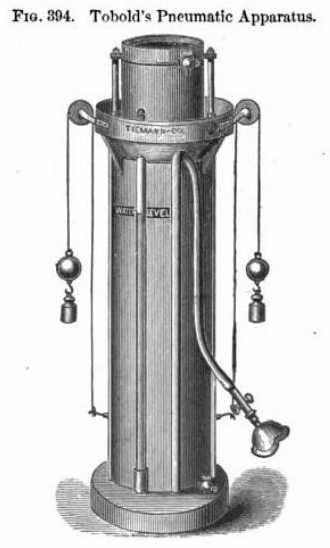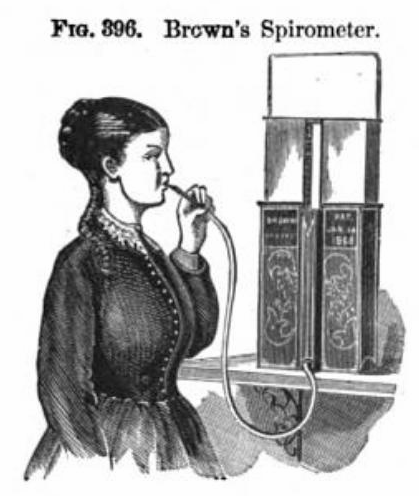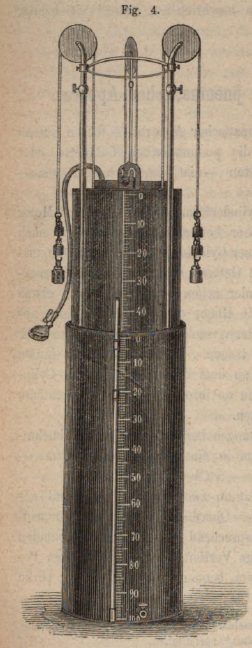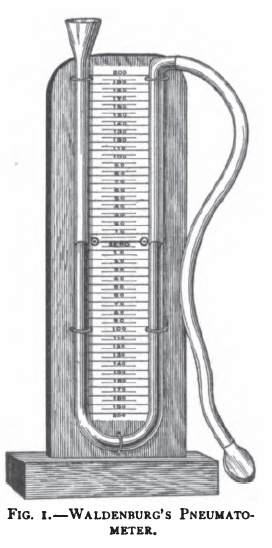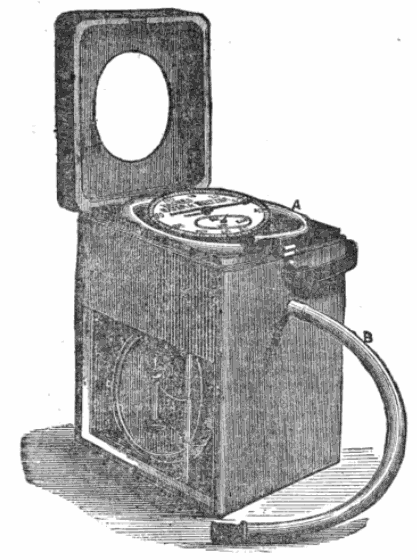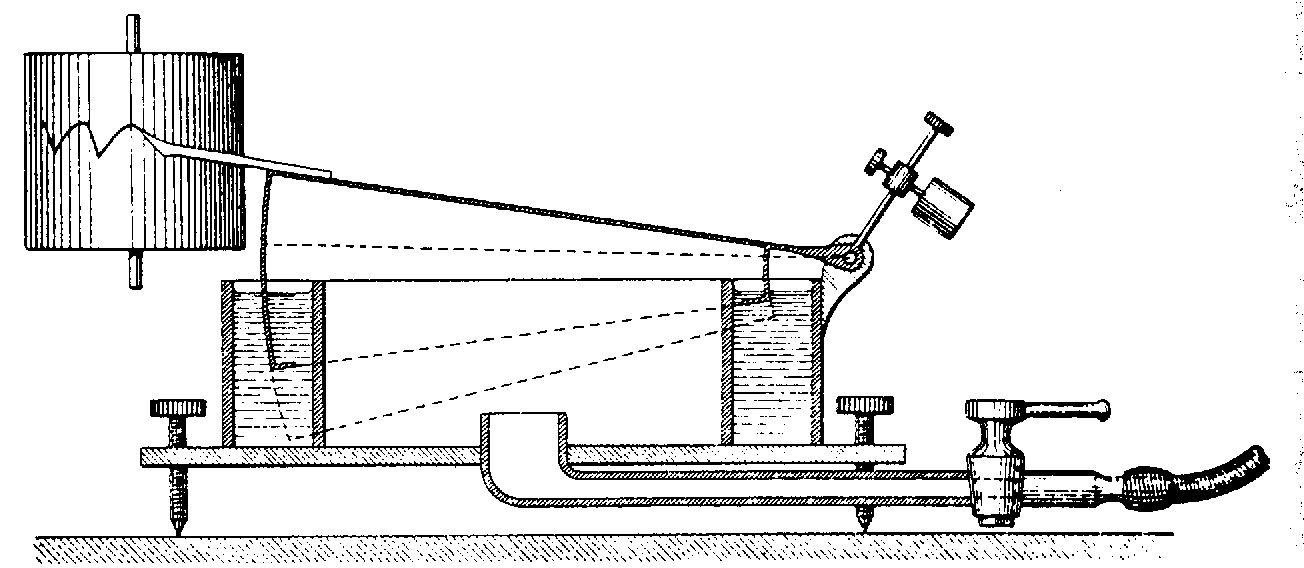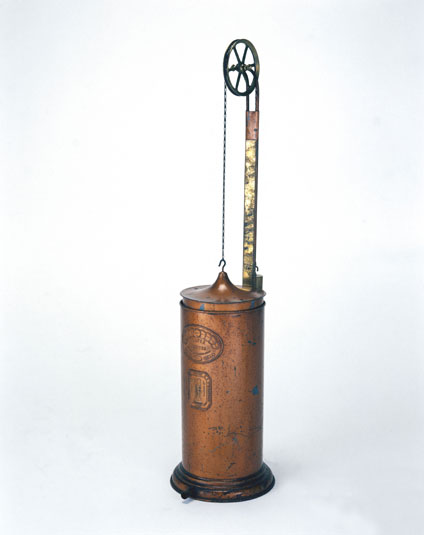Likely based on Waldenburg’s spirometry and therapy of compressed and rarified air for respiratory diseases. From: George Tiemann and Co. Catalog, The American Armamentarium Chirurgicum, 1879, page 99.
Category Archives: 1870s
Spirometer, Hutchinson, 1879
Spirometer, Brown’s, 1879
Spirometer, Waldenburg’s, 1875
Spirometer, Waldenburg’s, 1875
From: The Virginia Medical Journal, Volume 2, 1875, Page 685. “The principal parts of Waldenburg’s apparatus are two spirometer-like sheet zinc cylinders, fitting one into the other – the outer one meter high and 30 cm in diameter. The outer one is filled to a mark with water, as in the spirometer. The cover of the inner cylinder has an opening for a manometer, and one for a flexible tube leading to an ori-nasal mask. If the inner cylinder, resting on the bottom of the outer cylinder, with the stopcock closed is raised and and held by weight, the contained air is rarified; if this cylinder receives air at atmospheric pressure, and the stopcock is then closed, the cylinder being made to descend by weights, the air is condensed. According to the capacity of the lungs, 5-30 inhalations empty a fully charged apparatus.”
Waldenburg’s Pneumatometer
From: Pneutherapy including aerotherapy and inhalation methods and therapy. By Paul Louis Alexandre Tissier. 1903, page 25. “A U-shaped tube, open to the atmosphere and suitably mounted, is filled with mercury in both branches to the same level which is marked zero. One branch is connected with a rubber tube and mouthpiece (or mask or nosepiece) used by the person under observation, whose expiratory and inspiratory force is measured by the ascent or descent in the mercury in the other branch, as shown on a millimetric scale.”
Spirometer, Jagielski, 1879
From The London Medical Record, July 15, 1879, page 293. “Dr. Jagielski’s Spirometer. This instrument is made by Messrs. Mayer and Meltzer, surgical instrument makers, 71 Great Portland St. W., and combines all the advantages of correctness, convenient size, simple management and neat appearance. It is cased in Morocco leather with a leather handle at the top, so that the instrument can easily be carried about. The height is 9 inches; width 5 inches; depth 6-3/4; its weight 5 pounds, 14 ounces. The instrument has three horizontal compartments, one above the other. The lowest compartment is open to view having two glass windows, and is divided by a vertical partition, on either side of which there is a round diaphragm, containing a space of 10 cubic inches each when expanded or filled; these two chambers can be seen working alternately during expiration and inspiration, the one contracting when the other expands. The middle horizontal compartment containing the valve apparatus communicating the movements from the lower compartment to the indicating apparatus above. This latter, or recording apparatus, has a visible dial, for which a cut is left open in the movable cover; around the dial there is an open space large enough to hold the elastic breathing tube.”
“This spirometer gives the vital capacity for inspiration as well as expiration, the amount of which may be read on the dial on which there are two hands to be seen in rotation when used. The large one indicates every single cubic inch in inspiration when moving from the left to the right, and, in expiration from right to left; once around it records 100 single cubic inches. The small handle on the small dial from 100 to 150, 200, 300 cubic inches on one rotation, and moves in an opposite direction to that of the large handle. In blowing into the tube it must be done with but a moderate strength, so that the large hand may move on slowly and steadily; that the observer may be able to follow its movements on the register.”
“These instruments, used for several years, show no difference in their accurate registration from the first day of use, and do not require any particular care when put away. Price six guineas each.”
Spirometer, Gad’s Pneumatograph, 1879
Spirometer, Barnes, 1875, Advertisement
From The Herald of Health, 1875, January issue, page 93.
A description from: The Science and practice of medicine, Volume 2, 1866, By William Aitken, page 563: “The Lung Tester of A.P. Barnes (to be had of Messrs. Codman & Shurtleff, Boston) is the simplest and cheapest of all spirometric instruments. It consists of a cylindrical bag of India-rubber cloth, closed at each extremity by a disk of wood, and furnished with two metallic tubes; one tube enters laterally at the bottom, and is about three inches long; the other, vertical, is about twelve inches long, and graduated, and inserted in the centre of the upper disk. A flexible tube of proper length, with a mouthpiece is stretched over the outer aperture of the lower metal tube, and through this a forced expiration is made; the expired air fills, more or less, the bag and the vital capacity is recorded on the upper tube, which is forced up as the bag expands. The bag is enclosed in a tin cylinder, shut at both ends with two holes for the tubes.”
Spirometer, Walter Levoyer, 1876, Paris
Made by Walter Lecuyer, Paris, of iron and brass construction. Approx 1876
from http://www.sciencemuseum.org.uk/images/I019/10284273.aspx
